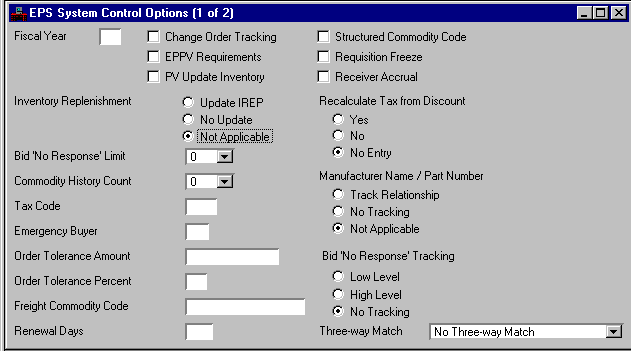|
|
|
|
Fiscal Year
|
Key field. Enter the fiscal year for which the options are in effect.
|
|
Change Order Tracking
|
Default is cleared [
N
]. Select [
Y
] if changes to purchase orders are tracked through the open purchase order modification windows. Leave cleared [
N
] if you do not want to track changes.
|
|
Structured Commodity Code
|
Default is cleared [
N
]. If selected [
Y
], the first three characters of the commodity code are moved to
Class
on Commodity (COMT) while the next two characters are moved to
Sub-Class
. This eliminates entering
Class
and
Sub-Class
on Commodity (COMT), which are now filled in by the system.
Clear [
N
] before loading Commodity (COMT) if you do not intend to use a structured commodity scheme.
|
|
EPPV Requirements
|
Default is cleared [
N
]. Select [
Y
] if the quantity and vendor invoice line number are required on documents that reference EPS purchase orders.
You should select [
Y
] this option if you intend to use the automated payment voucher process to process partial payments.
|
|
Requisition Freeze
|
Default is cleared [
N
]. Select [
Y
] if you want to freeze requisition documents upon acceptance and not allow them to be modified. Leave cleared [
N
] if you want to allow modifications to accepted requisition documents.
|
|
PV Update Inventory
|
Default is cleared [
N
]. Select [
Y
] to automatically adjust
Unit Price
on Inventory (INVN) according to the unit price inferred from payment vouchers.
|
|
Receiver Accrual
|
Default is cleared [
N
]. Select [
Y
] to allow the general ledger to be updated concurrently with the receipt of stock, rather than at the time of payment. This flag is used by the receipt of stock adjustment process to determine whether journal vouchers should be generated.
|
|
Inventory Replenishment
|
Default is
Not Applicable [blank]
. Select
Update IREP [Y]
if you want to use Inventory Replenishment (IREP).
|
|
Recalculate Tax from Discount
|
Default is
No Entry [blank]
. Select
Yes [Y]
if you want the taxes recalculated during automated disbursements based on any discounts applied. If a penalty applies, taxes are not recalculated regardless of the value of this field.
|
|
Bid 'No Response' Limit
|
Required. Valid values are
0
through
9
. This limit controls how many times a vendor may not respond to a bid before they are removed from the bidders list. A zero indicates that you will never automatically remove vendors from the list based on not responding to a bid.
|
|
Commodity History Count
|
Required. Valid values are
0
through
9
. This option establishes a limit on the number of records for a particular commodity on Commodity History (CHIS).
|
|
Manufacturer Name/Part Number
|
Conditional. Required if the Fleet Management Subsystem is installed. To avoid errors on Equipment Parts List (EQPL), select
Track Relationship [Y]
to track the relationship between vendor/commodity and manufacturer/part number. Otherwise, select
No Tracking [N]
or
Not Applicable [blank]
.
|
|
Tax Code
|
Optional. Enter a default tax code to be used on documents. See Tax Code (TAXT) for valid values.
|
|
Emergency Buyer
|
Required. Enter the buyer for all emergency requisitions. All emergency requisitions are routed to this buyer for processing. See Buyer (BUYT) for valid values.
|
|
Order Tolerance Amount
|
Required. Enter the maximum tolerance amount allowed between purchase orders and requisitions.
|
|
Bid 'No Response' Tracking
|
Required. This field establishes how the entry in
Bid 'No Response' Limit
is tracked. To track at the commodity level, select
Low Level [L]
. To track at the class/subclass level, select
High Level [H]
. If you do not want to track the `no responses', enter
No Tracking [N]
.
|
|
Order Tolerance Percent
|
Required. Enter the maximum tolerance percentage allowed between purchase orders and requisitions.
|
|
Freight Commodity Code
|
Required. Enter the commodity code which is used to record shipping/freight costs for an order. See Commodity Index (COMM) for valid values.
|
|
Renewal Days
|
Default is
0
(zero). This field is used as a default for
Renewal Days
on Price Agreement Summary (PASM). The field is used in conjunction with the Price Agreement Renewal Report.
|
|
Three-Way Match
|
Default is
No Three-Way Match [N]
. You should select a value other than
No Three-Way Match [N]
if you will be using EPPV and automatic payment voucher generation. For more information on automated payment vouchers, see the
User's Guide.
Valid values are:
PO, Receiver, and Vendor Invoice [A]
EPPV compares quantities found on Open Purchase Order Commodity Line Inquiry (OPPL) for the purchase order, receiver, and vendor invoice documents on a line by line basis. The document with the
lowest
quantity is paid.
PO and Receiver [R]
EPPV compares the quantities found on Open Purchase Order Commodity Line Inquiry (OPPC) for the receiver and the purchase order documents on a line by line basis. The document with the
lowest
quantity is paid. If a Vendor Invoice (VI) document is entered (even though it is not required) it is used in the comparison.
PO and Vendor Invoice [V]
EPPV compares the quantities found on Open Purchase Order Commodity Line Inquiry (OPPC) for the vendor invoice and purchase order documents on a line by line basis. The document with the
lowest
quantity is paid. If a Receiver (RC) document was entered (even though it is not required) it is used in the comparison.
No Three-Way Match [N]
No three-way processing takes place.
|




